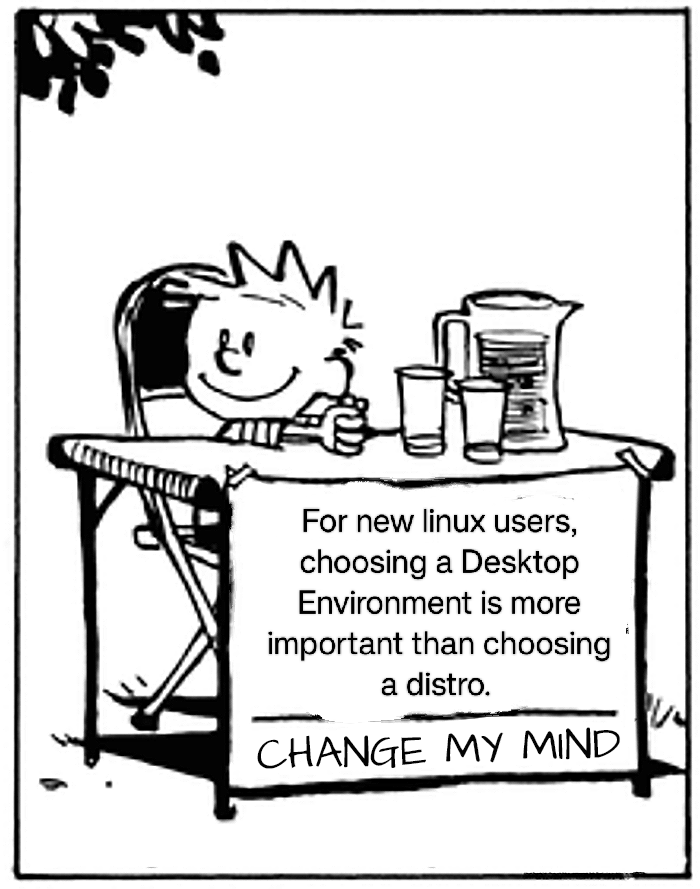this post was submitted on 21 Jan 2024
1757 points (97.8% liked)
linuxmemes
25025 readers
1630 users here now
Hint: :q!
Sister communities:
Community rules (click to expand)
1. Follow the site-wide rules
- Instance-wide TOS: https://legal.lemmy.world/tos/
- Lemmy code of conduct: https://join-lemmy.org/docs/code_of_conduct.html
2. Be civil
- Understand the difference between a joke and an insult.
- Do not harrass or attack users for any reason. This includes using blanket terms, like "every user of thing".
- Don't get baited into back-and-forth insults. We are not animals.
- Leave remarks of "peasantry" to the PCMR community. If you dislike an OS/service/application, attack the thing you dislike, not the individuals who use it. Some people may not have a choice.
- Bigotry will not be tolerated.
3. Post Linux-related content
- Including Unix and BSD.
- Non-Linux content is acceptable as long as it makes a reference to Linux. For example, the poorly made mockery of
sudoin Windows. - No porn, no politics, no trolling or ragebaiting.
4. No recent reposts
- Everybody uses Arch btw, can't quit Vim, <loves/tolerates/hates> systemd, and wants to interject for a moment. You can stop now.
5. 🇬🇧 Language/язык/Sprache
- This is primarily an English-speaking community. 🇬🇧🇦🇺🇺🇸
- Comments written in other languages are allowed.
- The substance of a post should be comprehensible for people who only speak English.
- Titles and post bodies written in other languages will be allowed, but only as long as the above rule is observed.
6. (NEW!) Regarding public figures
We all have our opinions, and certain public figures can be divisive. Keep in mind that this is a community for memes and light-hearted fun, not for airing grievances or leveling accusations. - Keep discussions polite and free of disparagement.
- We are never in possession of all of the facts. Defamatory comments will not be tolerated.
- Discussions that get too heated will be locked and offending comments removed.
Please report posts and comments that break these rules!
Important: never execute code or follow advice that you don't understand or can't verify, especially here. The word of the day is credibility. This is a meme community -- even the most helpful comments might just be shitposts that can damage your system. Be aware, be smart, don't remove France.
founded 2 years ago
MODERATORS
you are viewing a single comment's thread
view the rest of the comments
view the rest of the comments

Ext4 is the safe bet for a beginner. The real question is with or without LVM. Generally I would say with but that abstraction layer between the filesystem and disk can really be confusing if you've never dealt with it before. A total beginner should probably go ext4 without LVM and then play around in a VM with the various options to become informed enough to do something less vanilla.
This part is skippable, right? Any reason a user should ever care about this?
(note: never heard of LVM before this thread)
It makes adding space easier down the road, either by linking disks or if you clone your root drive to a larger drive, which tends to not be something most "end users" (I try not to use that description but you said it heh) would do. Yes, using LVM is optional.
It's all skippable if you want... Just put a large / filesystem on a partition and be on your way. There are good reasons for using it in some cases (see my response now).
This would absolutely be my thinking too. When I was still newish to linux, I remember lots of confusion with LVM and trying to reformat drives.
What is LVM?
Can you explain LVM in practice to me? I used ext4 and now Fedora Kinoite with BTRFS, the filsystem never makes any problems and some fancy features just work.
In practice, you would split a disk up to keep /home separate from/ and probably other parts of the filesystem too like /var/log.. this has long been an accepted practice to keep a full disk from bringing something production offline completely and/or complicating the recovery process. Now, you could use partitions but once those are set, it's hard to rearrange them without dumping all the data and restoring it under the new tables. LVM stands for Logical Volume Manager and puts an abstraction layer between the filesystems and the partitions (or whole disk if you are into that). This means you can add Disks arbitrarily in the future and add parts of those disks to the filesystems as required. This can really minimize or even eliminate downtime when you have a filesystem getting filled up and there's nothing you can easily remove (like a database).
It's good to know but with the proliferation of cloud and virtual disks it's just easier on those systems to leave off LVM and just keep the filesystems on their own virtual disks and grow the disk as required. It is invaluable when running important production systems on bare metal servers even today.
Hope this helps.
Thanks! So BTRFS does something similar with volumes, but baked in.
I should also point out that some modern filesystems like btrfs and zfs have these capabilities built into the filesystems natively so adding LVM into the mix there wouldn't add anything and could, in fact, cause headaches.